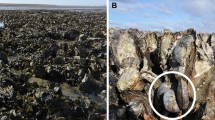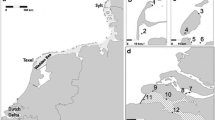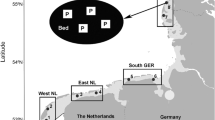Abstract
The introduction of species is of increasing concern as invaders often reduce the abundance of native species due to a variety of interactions like habitat engineering, predation and competition. A more subtle and not recognized effect of invaders on their recipient biota is their potential interference with native parasite–host interactions. Here, we experimentally demonstrate that two invasive molluscan filter-feeders of European coastal waters interfere with the transmission of free-living infective trematode larval stages and hereby mitigate the parasite burden of native mussels (Mytilus edulis). In laboratory mesocosm experiments, the presence of Pacific oysters (Crassostrea gigas) and American slipper limpets (Crepidula fornicata) reduced the parasite load in mussels by 65–77% and 89% in single and mixed species treatments, respectively. Both introduced species acted as decoys for the trematodes thus reducing the risk of hosts to become infected. This dilution effect was density-dependent with higher reductions at higher invader densities. Similar effects in a field experiment with artificial oyster beds suggest the observed dilution effect to be relevant in the field. As parasite infections have detrimental effects on the mussel hosts, the presence of the two invaders may elicit a beneficial effect on mussels. Our experiments indicate that introduced species alter native parasite–hosts systems thus extending the potential impacts of invaders beyond the usually perceived mechanisms.






Similar content being viewed by others
References
Aguirre-Macedo ML, Kennedy CR (1999) Diversity of metazoan parasites of the introduced oyster species Crassostrea gigas in the Exe Estuary. J Mar Biol Assoc UK 79:57–63. doi:10.1017/S002531549800006X
Bartoli P, Boudouresque C-F (1997) Transmission failure of parasites (Digenea) in sites colonized by the recently introduced invasive alga Caulerpa taxifolia. Mar Ecol Prog Ser 154:253–260. doi:10.3354/meps154253
Buck BH, Thieltges DW, Walter U, Nehls G, Rosenthal H (2005) Inshore–offshore comparison of parasite infestation in Mytilus edulis: implications for open ocean aquaculture. J Appl Ichthyol 21:107–113. doi:10.1111/j.1439-0426.2004.00638.x
Chernin E, Perlstein JM (1971) Protection of snails against miracidia of Schistosoma mansoni by various aquatic invertebrates. J Parasitol 57:217–219. doi:10.2307/3278017
Christensen NO, Frandsen F, Nansen P (1980) The interaction of some environmental factors influencing Schistosoma mansoni cercarial host-finding. J Helminthol 54:203–205
Day RW, Quinn GP (1989) Comparisons of treatments after an analysis of variance in ecology. Ecol Monogr 59:433–463. doi:10.2307/1943075
Diederich S (2005) Differential recruitment of introduced Pacific oysters and native mussels at the North Sea coast: coexistence possible? J Sea Res 53:269–281. doi:10.1016/j.seares.2005.01.002
Diederich S, Nehls G, van Beusekom JEE, Reise K (2005) Introduced Pacific oysters (Crassostrea gigas) in the northern Wadden Sea: invasion accelerated by warm summers? Helgol Mar Res 59:97–106. doi:10.1007/s10152-004-0195-1
Fredensborg BL, Mouritsen KN, Poulin R (2004) Intensity-dependent mortality of Paracalliope novizealandiae (Amphipoda: Crustacea) infected by a trematode: experimental infections and field observations. J Exp Mar Biol Ecol 311:253–265. doi:10.1016/j.jembe.2004.05.011
Gozlan RE, St-Hilaire S, Feist SW, Martin P, Kents ML (2005) Disease threat to European fish. Nature 435:1046. doi:10.1038/4351046a
Jensen KT, Castro N, Bachelet G (1999) Infectivity of Himasthla spp. (Trematoda) in cockle (Cerastoderma edule) spat. J Mar Biol Assoc UK 79:265–271. doi:10.1017/S0025315498000290
Keesing F, Holt RD, Ostfeld RS (2006) Effects of species diversity on disease risk. Ecol Lett 9:485–498. doi:10.1111/j.1461-0248.2006.00885.x
Kennedy CR (1993) Introductions, spread and colonization of new localities by fish helminth and crustacean parasites in the British Isles: a perspective and appraisal. J Fish Biol 43:287–301. doi:10.1111/j.1095-8649.1993.tb00429.x
Kittner C, Riisgård HU (2005) Effect of temperature on filtration rate in the mussel Mytilus edulis: no evidence for temperature compensation. Mar Ecol Prog Ser 305:147–152. doi:10.3354/meps305147
Kopp K, Jokela J (2007) Resistant invaders can convey benefits to native species. Oikos 116:295–301. doi:10.1111/j.0030-1299.2007.15290.x
Krakau M, Thieltges DW, Reise K (2006) Native parasites adopt introduced bivalves of the North Sea. Biol Invasions 8:919–925. doi:10.1007/s10530-005-4734-8
Lauckner G (1983) Diseases of Mollusca: Bivalvia. In: Kinne O (ed) Diseases of marine animals vol 2: introduction, Bivalvia to Scaphopoda. Biologische Anstalt Helgoland, Hamburg, pp 477–961
Lesser MP, Shumway SE, Cucci T, Smith J (1992) Impact of fouling organisms on mussel rope culture: interspecific competition for food among suspension-feeding invertebrates. J Exp Mar Biol Ecol 165:91–102. doi:10.1016/0022-0981(92)90291-H
Mooney HA, Mack RN, McNeely JA (eds) (2005) Invasive alien species: a new synthesis. Island Press, Washington, DC
Morley NJ, Lewis JW (2004) Free-living endohelminths: the influence of multiple factors. Trends Parasitol 20:114–115. doi:10.1016/j.pt.2003.12.002
Mouritsen KN, Poulin R (2003) The mud flat anemone-cockle association: mutualism in the intertidal zone? Oecologia 135:131–137
Mouritsen KN, McKechnie S, Meenken E, Toynbee J, Poulin R (2003) Spatial heterogeneity in parasite loads in the New Zealand cockle: the importance of host condition and density. J Mar Biol Assoc UK 83:307–310. doi:10.1017/S0025315403007124h
Nehls G, Diederich S, Thieltges DW, Strasser M (2006) Wadden Sea mussel beds invaded by oysters and slipper limpets—competition or climate control? Helgol Mar Res 60:135–143. doi:10.1007/s10152-006-0032-9
Newell RC, Kofoed LH (1977) The energetics of suspension-feeding in the gastropod Crepidula fornicata L. J Mar Biol Assoc UK 57:161–180
Olden JD, Poff NL, Douglas MR, Douglas ME, Fausch KD (2004) Ecological and evolutionary consequences of biotic homogenisation. Trends Ecol Evol 19:18–24. doi:10.1016/j.tree.2003.09.010
Ostfeld RS, Keesing F (2000) Biodiversity and disease risk: the case of Lyme disease. Conserv Biol 14:722–728. doi:10.1046/j.1523-1739.2000.99014.x
Pechenik JA, Fried B, Simpkins HL (2001) Crepidula fornicata is not a first intermediate host for trematodes, who is? J Exp Mar Biol Ecol 261:211–224. doi:10.1016/S0022-0981(01)00270-2
Pietrock M, Marcogliese DJ (2003) Free-living endohelminth stages: at the mercy of environmental conditions. Trends Parasitol 19:293–299. doi:10.1016/S1471-4922(03)00117-X
Pimentel D (ed) (2002) Biological invasions—economic and environmental costs of alien plant, animal, and microbe species. CRC Press, Boca Raton, FL
Ren JS, Ross AH, Schiel DR (2000) Functional descriptions of feeding and energetics of the Pacific oyster Crassostrea gigas in New Zealand. Mar Ecol Prog Ser 208:119–130. doi:10.3354/meps208119
Ropert M, Goulletquer P (2000) Comparative physiological energetics of two suspension feeders: polychaete annelid Lanice conchilega (Pallas 1766) and Pacific cupped oyster Crassostrea gigas (Thunberg 1795). Aquaculture 181:171–189. doi:10.1016/S0044-8486(99)00216-1
Sax DF, Stachowicz JJ, Gaines ST (eds) (2005) Species invasions: insights into ecology, evolution and biogeography. Sinauer Associates, Sunderland, Massachusetts
Taraschewski H (2006) Hosts and parasites as aliens. J Helminthol 80:99–128. doi:10.1079/JOH2006364
Thieltges DW (2005) Impact of an invader: epizootic American slipper limpet Crepidula fornicata reduces survival and growth in European mussels. Mar Ecol Prog Ser 286:13–19. doi:10.3354/meps286013
Thieltges DW (2006) Effect of metacercarial trematode infections (Renicola roscovita) on growth in intertidal blue mussels (Mytilus edulis). Mar Ecol Prog Ser 319:129–134. doi:10.3354/meps319129
Thieltges DW, Reise K (2007) Spatial heterogeneity in parasite infections at different scales in an intertidal bivalve. Oecologia 150:569–581. doi:10.1007/s00442-006-0557-2
Thieltges DW, Rick J (2006) Effect of temperature on emergence, survival and infectivity of cercariae of the marine trematode Renicola roscovita (Digenea: Renicolidae). Dis Aquat Organ 73:63–68. doi:10.3354/dao073063
Thieltges DW, Strasser M, Reise K (2003) The American slipper-limpet Crepidula fornicata (L.) in the Northern Wadden Sea 70 years after its introduction. Helgol Mar Res 57:27–33
Thieltges DW, Strasser M, van Beusekom JEE, Reise K (2004) Too cold to prosper—winter mortality prevents population increase of the introduced American slipper limpet Crepidula fornicata in northern Europe. J Exp Mar Biol Ecol 311:375–391. doi:10.1016/j.jembe.2004.05.018
Thieltges DW, Jensen KT, Poulin R (2008a) The role of biotic factors in the transmission of free-living endohelminth stages. Parasitology 135:407–426. doi:10.1017/S0031182007000248
Thieltges DW, Donas-Botto Bordalo M, Cabalero Hernández A, Prinz K, Jensen KT (2008b) Ambient fauna impairs parasite transmission in a marine parasite–host system. Parasitology 135:1111–1116
Torchin ME, Lafferty KD, Dobson AP, McKenzie VJ, Kuris AM (2003) Introduced species and their missing parasites. Nature 421:628–630. doi:10.1038/nature01346
Torchin ME, Lafferty KD, Kuris AM (2002) Parasites and marine invasions. Parasitology 124:S137–S151. doi:10.1017/S0031182002001506
Upatham ES, Sturrock RF (1973) Field investigations on the effect of other aquatic animals on the infection of Biomphalaria glabrata by Schistosoma mansoni miracidia. J Parasitol 59:448–453. doi:10.2307/3278770
Wegeberg AM, de Montaudouin X, Jensen KT (1999) Effect of intermediate host size (Cerastoderma edule) on infectivity of cercariae of three Himasthla species (Echinostomatidae, Trematoda). J Exp Mar Biol Ecol 238:259–269. doi:10.1016/S0022-0981(98)00177-4
Acknowledgements
We wish to thank Maria Donas-Bôtto Bordalo and Alejandro Caballero Hernández for help with the experiments. For help with the ring experiment at Sylt we thank Christian Buschbaum, Patrick Polte and Nils Volkenborn. This work was supported by a fellowship to DWT within the Postdoc-Programme of the German Academic Exchange Service (DAAD).
Author information
Authors and Affiliations
Corresponding author
Rights and permissions
About this article
Cite this article
Thieltges, D.W., Reise, K., Prinz, K. et al. Invaders interfere with native parasite–host interactions. Biol Invasions 11, 1421–1429 (2009). https://doi.org/10.1007/s10530-008-9350-y
Received:
Accepted:
Published:
Issue Date:
DOI: https://doi.org/10.1007/s10530-008-9350-y




